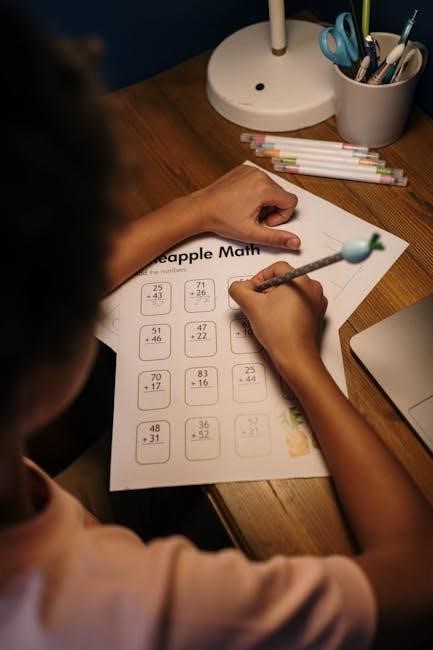Mixed numbers combine whole numbers and fractions, requiring like denominators for easy addition and subtraction. Mastering these operations is essential for real-world applications and academic success.
Definition of Mixed Numbers
A mixed number is a combination of a whole number and a proper fraction, written together as a single value (e.g., 2 3/4). The whole number represents complete units, while the fraction shows a part of a whole. Proper fractions, where the numerator is less than the denominator, are essential for forming mixed numbers. This format is useful in real-world applications, such as cooking or measurements, where both whole items and partial amounts are involved. Understanding mixed numbers simplifies operations like addition and subtraction.
Importance of Like Denominators in Fraction Operations
Like denominators are crucial for adding and subtracting fractions as they ensure the parts being compared are equal. When denominators are the same, the numerators can be directly added or subtracted, simplifying calculations. This consistency eliminates the need for conversion and reduces errors, making operations more straightforward and efficient. Proper alignment of fractions with like denominators is essential for accurate results in mixed number operations.

Basic Steps for Adding Mixed Numbers with Like Denominators
First, add the whole numbers separately. Then, add the fractions, ensuring like denominators. Finally, combine the sums, converting any improper fractions to mixed numbers if needed.
Step 1: Align the Whole Numbers and Fractions
When adding mixed numbers, begin by writing the whole numbers directly above each other in a column. Next, align the fractional parts beneath them. This ensures that the whole numbers and fractions are properly organized for accurate calculation. Proper alignment helps prevent errors and simplifies the addition process. Always double-check that the denominators are the same, as this step is crucial for successful mixed number operations.
Step 2: Add the Whole Numbers Separately
Add the whole number parts of the mixed numbers first, keeping the fractions aside. For example, in 3 1/4 + 2 3/4, add 3 and 2 to get 5. Write this sum next to the whole numbers to keep track. This step is straightforward but crucial, as it separates the whole numbers from the fractions, ensuring accuracy. Remember, only the whole numbers are added at this stage, while the fractions remain untouched for the next step. This separation simplifies the overall process.
Step 3: Add the Fraction Parts
After adding the whole numbers, focus on the fractions. Since the denominators are the same, simply add the numerators. For example, in 3 1/4 + 2 3/4, add 1 and 3 to get 4. The fraction becomes 4/4, which simplifies to 1. Adding fractions with like denominators is straightforward—just add the numerators and keep the denominator the same. This step ensures the fractional parts are combined correctly before moving on to the final combination.
Step 4: Combine the Results
After adding the whole numbers and fractions separately, combine the results. For example, if you have 5 + 2 = 7 for the whole numbers and 1/4 + 3/4 = 1 for the fractions, add these together to get 7 + 1 = 8. If the fraction result is an whole number, add it directly to the whole number sum. This final step gives the complete result of the mixed number addition. Always simplify if possible for the most accurate answer.
Basic Steps for Subtracting Mixed Numbers with Like Denominators
Subtract whole numbers and fractions separately. Start with the whole numbers, then the fractions. If needed, borrow from the whole number to complete the subtraction.
Step 1: Subtract the Whole Numbers
Begin by subtracting the whole number parts of the mixed numbers. Ensure the larger whole number is subtracted from the smaller one. If the result is zero, move to the fraction part. Always perform this step before addressing the fractions to maintain clarity and accuracy in the calculation. Properly handling the whole numbers sets the foundation for correctly managing the fractional components in the next steps.
Step 2: Subtract the Fraction Parts
After handling the whole numbers, focus on the fraction parts. Ensure the denominators are the same for straightforward subtraction. Subtract the numerators while keeping the denominator unchanged. If the result is an improper fraction, convert it to a mixed number. Simplify the fraction if possible. This step maintains clarity and ensures accurate results in mixed number subtraction. Always handle the fractions after the whole numbers for consistency and correctness in the overall calculation. Proper management of the fraction parts is crucial for obtaining the correct final result, especially when borrowing is involved. Simplifying fractions at this stage helps in presenting a clear and precise answer, avoiding unnecessary complexity. Remember, the goal is to maintain the integrity of the whole numbers and fractions separately to ensure the subtraction process remains organized and error-free. By following this step carefully, you can avoid common mistakes and ensure the subtraction of mixed numbers with like denominators is executed flawlessly. This systematic approach reinforces mathematical accuracy and builds a strong foundation for more complex operations involving mixed numbers. Always double-check your work to confirm that both the whole number and fraction parts align correctly, guaranteeing the validity of your solution. With practice, this step becomes second nature, enhancing your overall proficiency in handling mixed number subtractions. Keep in mind that attention to detail is key, especially when dealing with borrowing or simplifying fractions, as it directly impacts the final outcome. By mastering this step, you will be well-equipped to tackle a variety of mixed number subtraction problems with confidence and precision. This methodical approach ensures that each component of the mixed numbers is addressed appropriately, leading to consistent and reliable results. Embrace this structured technique to improve your mathematical skills and problem-solving abilities. Always strive for clarity and correctness in each step to maintain the integrity of your calculations. With dedication and practice, subtracting mixed numbers with like denominators will become a breeze, allowing you to progress to more challenging mathematical concepts with ease. Remember, understanding and applying each step meticulously is the cornerstone of excelling in arithmetic operations. So, take your time, stay focused, and ensure each part of the process is executed accurately. The rewards of precise calculations will be evident in your academic and real-world applications, providing a solid foundation for future success. By adhering to this methodical approach, you will not only master the subtraction of mixed numbers but also develop a deeper appreciation for the logical structure of mathematics. Keep practicing, and soon you’ll find these operations becoming increasingly intuitive and effortless. The key to success lies in consistent practice and a commitment to understanding each underlying principle. With persistence and determination, you’ll unlock the full potential of your mathematical abilities, paving the way for a brighter academic future. Always remember, every great mathematician started with the basics, and mastery of these fundamental operations is the first step toward achieving excellence in mathematics. So, stay motivated, keep learning, and watch your skills flourish with each passing day. The world of mathematics is full of endless possibilities, and by conquering these foundational skills, you’ll be ready to embrace whatever challenges come your way. Let your dedication to learning guide you toward a future filled with intellectual growth and discovery. With each problem you solve, you’re one step closer to achieving your full potential. So, keep pushing forward, and never lose sight of your goals. The journey to mathematical excellence is a lifelong path, and every step you take brings you closer to realizing your aspirations. Embrace the process, learn from your mistakes, and let your passion for learning propel you to new heights. The sky’s the limit when you combine determination with a love for mathematics; So, go ahead, take the next step, and continue to explore the fascinating world of numbers and operations; Your journey to mathematical mastery is just beginning, and the possibilities are endless. Stay curious, keep exploring, and never stop striving for greatness. With each new concept you learn, you’re building a stronger foundation for future success. So, cherish the learning process, embrace challenges, and let your love for mathematics shine through in everything you do. The rewards of your hard work and dedication will be immeasurable, and the sense of accomplishment you’ll feel will be truly fulfilling. Keep reaching for the stars, and remember that every small step forward is a testament to your commitment to excellence. Mathematics is a beautiful and intricate language, and by mastering its principles, you’ll unlock the door to a world of understanding and opportunity. So, stay engaged, remain curious, and let your passion for learning guide you on this incredible journey. The adventure of discovering and mastering mathematical concepts is one that will enrich your life in countless ways, providing you with the tools to solve problems, think critically, and approach challenges with confidence. With persistence and dedication, you’ll continue to grow and flourish, achieving heights you never thought possible. So, keep up the excellent work, stay focused, and remember that every challenge is an opportunity to learn and improve. The journey may not always be easy, but the rewards are well worth the effort. Stay motivated, keep pushing forward, and let your love for mathematics inspire you to reach new heights. The world of numbers is full of endless possibilities, and by embracing it, you’ll find that the opportunities for growth and discovery are limitless. So, keep exploring, stay curious, and let your passion for learning shine through in everything you do. The sky’s the limit, and with determination and hard work, you’ll achieve all your goals and more. Remember, every great achievement starts with a single step, and by taking that step today, you’re paving the way for a brighter tomorrow. So, go ahead, embrace the challenge, and let your journey to mathematical excellence begin. The future is bright, and with your dedication, it’s filled with promise and potential. Keep striving for greatness, and never settle for anything less than your best. The world of mathematics is waiting for you, and with your passion and commitment, you’ll make your mark and achieve incredible things. So, stay focused, keep learning, and let your love for numbers guide you on this exciting adventure. The possibilities are endless, and the journey is just beginning. Let’s make it a journey to remember.
Step 3: Handle Borrowing if Necessary
If the fraction part of the minuend is smaller than the subtrahend, borrowing is required. Convert one whole number from the minuend into a fraction with the same denominator. Add this to the fraction part, then subtract. Ensure the whole numbers are adjusted accordingly. Borrowing maintains the integrity of the operation, preventing negative results. Always simplify the fraction after borrowing to present a clear and accurate final answer. This step is crucial for maintaining the balance of the equation and ensuring the subtraction process remains valid. Proper handling of borrowing avoids errors and ensures the correct representation of both whole numbers and fractions. By converting a whole number into a fraction, you maintain consistency in the operation, allowing for precise subtraction. Remember, borrowing is essential when the fraction part is insufficient, ensuring the operation proceeds smoothly. Always double-check your borrowing to confirm that the adjusted values align correctly, guaranteeing the validity of your solution. With practice, this step becomes second nature, enhancing your overall proficiency in handling mixed number subtractions. Keep in mind that attention to detail is key, especially when dealing with borrowing, as it directly impacts the final outcome. By mastering this step, you will be well-equipped to tackle a variety of mixed number subtraction problems with confidence and precision. This methodical approach ensures that each component of the mixed numbers is addressed appropriately, leading to consistent and reliable results. Embrace this structured technique to improve your mathematical skills and problem-solving abilities. Always strive for clarity and correctness in each step to maintain the integrity of your calculations. With dedication and practice, subtracting mixed numbers with like denominators will become a breeze, allowing you to progress to more challenging mathematical concepts with ease. Remember, understanding and applying each step meticulously is the cornerstone of excelling in arithmetic operations. So, take your time, stay focused, and ensure each part of the process is executed accurately. The rewards of precise calculations will be evident in your academic and real-world applications, providing a solid foundation for future success. By adhering to this methodical approach, you will not only master the subtraction of mixed numbers but also develop a deeper appreciation for the logical structure of mathematics. Keep practicing, and soon you’ll find these operations becoming increasingly intuitive and effortless. The key to success lies in consistent practice and a commitment to understanding each underlying principle. With persistence and determination, you’ll unlock the full potential of your mathematical abilities, paving the way for a brighter academic future. Always remember, every great mathematician started with the basics, and mastery of these fundamental operations is the first step toward achieving excellence in mathematics. So, stay motivated, keep learning, and watch your skills flourish with each passing day. The world of mathematics is full of endless possibilities, and by conquering these foundational skills, you’ll be ready to embrace whatever challenges come your way. Let your dedication to learning guide you toward a future filled with intellectual growth and discovery. With each problem you solve, you’re one step closer to achieving your full potential. So, keep pushing forward, and never lose sight of your goals. The journey to mathematical excellence is a lifelong path, and every step you take brings you closer to realizing your aspirations. Embrace the process, learn from your mistakes, and let your passion for learning propel you to new heights. The sky’s the limit when you combine determination with a love for mathematics. So, go ahead, take the next step, and continue to explore the fascinating world of numbers and operations. Your journey to mathematical mastery is just beginning, and the possibilities are endless. Stay curious, keep exploring, and never stop striving for greatness. With each new concept you learn, you’re building a stronger foundation for future success. So, cherish the learning process, embrace challenges, and let your love for mathematics shine through in everything you do. The rewards of your hard work and dedication will be immeasurable, and the sense of accomplishment you’ll feel will be truly fulfilling. Keep reaching for the stars, and remember that every small step forward is a testament to your commitment to excellence. Mathematics is a beautiful and intricate language, and by mastering its principles, you’ll unlock the door to a world of understanding and opportunity. So, stay engaged, remain curious, and let your passion for learning guide you on this incredible journey. The adventure of discovering and mastering mathematical concepts is one that will enrich your life in countless ways, providing you with the tools to solve problems, think critically, and approach challenges with confidence. With persistence and dedication, you’ll continue to grow and flourish, achieving heights you never thought possible. So, keep up the excellent work, stay focused, and remember that every challenge is an opportunity to learn and improve. The journey may not always be easy, but the rewards are well worth the effort. Stay motivated, keep pushing forward, and let your love for mathematics inspire you to reach new heights. The world of numbers is full of endless possibilities, and by embracing it, you’ll find that the opportunities for growth and discovery are limitless. So, keep exploring, stay curious, and let your passion for learning shine through in everything you do. The sky’s the limit, and with determination and hard work, you’ll achieve all your goals and more. Remember, every great achievement starts with a single step, and by taking that step today, you’re paving the way for a brighter tomorrow. So, go ahead, embrace the challenge, and let your journey to mathematical excellence begin. The future is bright, and with your dedication, it’s filled with promise and potential. Keep striving for greatness, and never settle for anything less than your best. The world of mathematics is waiting for you, and with your passion and commitment, you’ll make your mark and achieve incredible things. So, stay focused, keep learning, and let your love for numbers guide you on this exciting adventure. The possibilities are endless, and the journey is just beginning. Let’s make it a journey to remember.

Examples of Adding Mixed Numbers with Like Denominators
Examples illustrate the method of adding whole numbers and fractions separately, highlighting how like denominators simplify the addition process for mixed numbers, resulting in a combined whole number or mixed number.
Example 1: Adding Two Mixed Numbers
Adding two mixed numbers with like denominators involves separate addition of whole numbers and fractions. For instance, to add 3 1/4 and 2 3/4, first add the whole numbers: 3 + 2 = 5. Then add the fractions: 1/4 + 3/4 = 1. Combine the results: 5 + 1 = 6. If the fraction sum exceeds 1, convert it to a mixed number and add to the whole number sum. This method ensures accuracy and simplifies the process for like denominators.
Example 2: Adding Three or More Mixed Numbers
When adding three or more mixed numbers with like denominators, follow the same steps as adding two. For example, add 3 1/4, 2 3/4, and 1 1/2. First, add the whole numbers: 3 + 2 + 1 = 6. Then, add the fractions: 1/4 + 3/4 + 1/2 = 1 1/2. Finally, combine the whole number sum with the fraction sum: 6 + 1 1/2 = 7 1/2. This method works seamlessly for any number of mixed numbers with like denominators.

Examples of Subtracting Mixed Numbers with Like Denominators
Subtracting mixed numbers with like denominators involves whole number subtraction and fraction subtraction. Ensure denominators are the same before performing the operation. This method simplifies calculations and avoids conversion errors.
Example 1: Subtracting Two Mixed Numbers
Subtracting two mixed numbers with like denominators involves two main steps. First, subtract the whole numbers separately. Then, subtract the fractional parts. If the fraction subtraction results in a negative number, borrow one whole number from the larger mixed number, convert it to a fraction, and add it to the smaller fraction. Finally, combine the results of the whole number and fraction subtractions to get the final answer. This method ensures accuracy and simplifies the process for beginners.
Example 2: Subtracting Mixed Numbers with Borrowing
When subtracting mixed numbers with like denominators, borrowing is necessary if the fraction part of the smaller number is larger than the fraction part of the larger number. For example, subtracting (2 rac{3}{4}) from (1 rac{1}{2}): First, borrow 1 from the whole number, converting (1 rac{1}{2}) to (0 rac{3}{2}). Then, subtract the fractions: ( rac{3}{2} ‒ rac{3}{4} = rac{3}{4}). Finally, subtract the whole numbers: (0 ‒ 2 = -2). The result is (-1 rac{1}{4}). This step-by-step process ensures accurate results when borrowing is required.

Common Mistakes to Avoid
Common mistakes include ignoring the whole number part, forgetting to align fractions properly, and mismanaging the borrowing process, leading to incorrect results.
Ignoring the Whole Number Part
A common error is forgetting to account for the whole number portion of mixed numbers. This oversight can lead to incorrect results, as both the whole numbers and fractions must be handled separately during addition or subtraction. When adding, for instance, one should first add the whole numbers and then the fractions. Similarly, when subtracting, the whole numbers must be subtracted before addressing the fractional parts. Neglecting this step can cause significant errors in the final answer, making it essential to always prioritize separating and calculating each part individually.
Forgetting to Align the Fractions Properly
One of the most frequent mistakes is failing to align the fractional parts correctly during addition or subtraction. Misaligning fractions can result in incorrect calculations, as the denominators must match for proper comparison. To avoid this, ensure that the fractional portions of mixed numbers are directly beneath each other when writing problems vertically. This clear alignment helps maintain focus on like denominators, reducing errors and ensuring accurate results. Proper formatting is key to successful mixed number operations.
Mismanaging the Borrowing Process
Mismanaging the borrowing process is a common error when subtracting mixed numbers. If the fraction part of the minuend is smaller than the subtrahend, borrowing from the whole number is necessary. However, improper borrowing, such as borrowing more than needed or failing to adjust the whole numbers correctly, leads to incorrect results. Always ensure the fraction part is properly converted and the whole numbers are adjusted accurately. This prevents errors and ensures smooth subtraction of mixed numbers with like denominators.

Real-World Applications of Mixed Number Operations
Mixed numbers are essential in cooking, where ingredients often require precise measurements. They also apply in financial calculations, like budgeting, and crafting projects, ensuring accuracy in measurements.
Cooking and Baking
Cooking and baking frequently require adjusting recipes, where mixed numbers are essential for precise measurements. For example, doubling a recipe might involve adding 2 ¾ cups of flour to 1 ¼ cups of sugar. Understanding how to add and subtract mixed numbers with like denominators ensures accurate ingredient proportions, which is crucial for achieving the desired taste and texture in dishes. This practical application makes mastering these operations invaluable for both novice and experienced cooks.
Crafting and DIY Projects
Crafting and DIY projects often involve measuring materials precisely. Adding and subtracting mixed numbers with like denominators is essential for tasks like cutting fabric or wood. For instance, if a project requires 3 ½ yards of fabric and you have 2 ⅓ yards already, subtracting these mixed numbers helps determine how much more fabric to purchase. This skill ensures accuracy and minimizes waste, making it a valuable tool for crafters and DIY enthusiasts working on various creative endeavors.
Financial Calculations
Financial calculations frequently involve mixed numbers, especially in budgeting and accounting. For example, when managing expenses, adding and subtracting mixed numbers with like denominators helps track income and spending accurately. If a budget allocates 5 ¾ percent for savings and 3 ¼ percent for utilities, these operations ensure precise financial planning. Mastery of this skill is crucial for maintaining financial stability and making informed economic decisions, whether personal or professional.

Where to Find Worksheets on Adding and Subtracting Mixed Numbers
Educational websites offer a variety of adding and subtracting mixed numbers worksheets. Popular platforms include Teachers Pay Teachers and Math Worksheets Land for PDF resources, ideal for classroom and homework use.
Recommended Websites for PDF Worksheets
Popular websites like Teachers Pay Teachers, Math Worksheets Land, and Khan Academy offer a wide range of free and premium PDF worksheets for adding and subtracting mixed numbers. These platforms provide customizable options, making them ideal for classroom use or homeschooling. Additionally, Educate.com and Math Goodies offer printable resources with answer keys, ensuring comprehensive practice and self-assessment. These sites cater to diverse learning needs and skill levels, making them excellent choices for teachers and students alike.
Specific Worksheet Recommendations
For targeted practice, try the “Mixed Numbers Operations” worksheet from Math Worksheets 4 Kids. This resource includes 20 problems with like denominators, ideal for reinforcing addition and subtraction skills. Another excellent option is K12 Workbook’s “Fraction Operations” PDF, offering clear instructions and varied exercises. Both worksheets feature answer keys, ensuring students can verify their work and track progress effectively, making them valuable tools for both classroom and independent study settings.

How to Use Worksheets Effectively
Start with simple problems to build confidence, then gradually increase difficulty. Use answer keys for self-assessment and focus on understanding each step thoroughly before moving on.
Starting with Simple Problems
Begin with worksheets featuring straightforward adding and subtracting of mixed numbers with like denominators. Start with problems where whole numbers and fractions are aligned, ensuring clarity. Use visual aids like fraction bars or models to help students grasp concepts visually. Simple problems build foundational skills and confidence, allowing learners to focus on understanding the process without feeling overwhelmed. Gradually introduce more complex scenarios once basic proficiency is achieved, ensuring a smooth progression in skill development.
Gradually Increasing Difficulty
After mastering simple problems, worksheets should introduce more challenging scenarios. Start by adding or subtracting mixed numbers with larger whole number parts or fractions. Incorporate problems requiring regrouping or borrowing, ensuring students apply concepts like improper fractions. As confidence grows, introduce mixed operations (both addition and subtraction) in a single worksheet. This gradual progression helps reinforce skills and prepares learners for complex, real-world applications of mixed number operations.
Using Answer Keys for Self-Assessment
Answer keys are invaluable for self-assessment, allowing students to verify their solutions independently. After completing worksheets, learners can compare their answers to the provided keys. This process helps identify errors and strengthens understanding. Encourage students to review incorrect answers step-by-step, ensuring they grasp where mistakes occurred. Regular use of answer keys fosters self-directed learning and builds confidence in mastering mixed number operations.

Interactive Activities to Supplement Worksheets
Answer keys enable students to verify solutions, identify errors, and understand mistakes. Regular review with keys enhances learning and builds confidence in mixed number operations.
Online Games for Mixed Number Practice
Engaging online games offer an interactive way to practice adding and subtracting mixed numbers. Platforms like Khan Academy and Math Playground provide step-by-step exercises, quizzes, and challenges. These games often include visual aids, such as fraction models, to enhance understanding. Students can earn rewards, track progress, and compete with peers, making learning fun and motivating. Many games are designed for classroom or home use, complementing worksheets and reinforcing skills through dynamic, real-time feedback and interactive problem-solving.
Math Apps for Hands-On Learning
Math apps like Khan Academy Kids and Math Games provide interactive, hands-on experiences for mastering mixed number operations. These apps use visual simulations, allowing students to convert mixed numbers to improper fractions and vice versa. They offer guided lessons, quizzes, and puzzles that adapt to skill levels. Features like touch-based manipulation of fractions and real-time feedback make learning engaging. Many apps also include progress tracking, helping students and teachers monitor improvement. These tools are perfect for reinforcing worksheet concepts in a dynamic, interactive environment.
Classroom Group Activities
Classroom group activities enhance engagement and understanding when learning to add and subtract mixed numbers. Teachers can organize collaborative problem-solving sessions, where students work in pairs or small groups to solve worksheet problems. Peer teaching and discussions encourage deeper comprehension. Activities like “Fraction Match” games or creating real-world scenarios involving mixed numbers foster teamwork and practical application. These interactive approaches help students visualize concepts and reinforce skills in a social, dynamic learning environment while promoting mutual support and shared success.

Visual Aids for Better Understanding
Visual aids like videos, interactive whiteboard lessons, and printable fraction charts help students grasp mixed number operations. They make abstract concepts more tangible and engaging for learners.